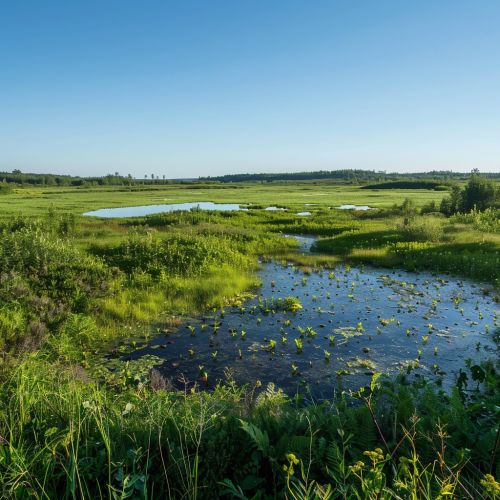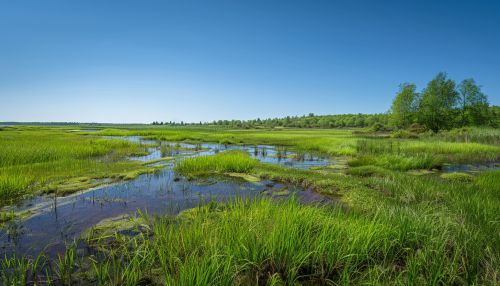Bog
Introduction
A bog is a type of wetland that accumulates peat, a deposit of dead plant material. Bogs are characterized by their water chemistry, which is low in nutrients and acidic. The water in a bog is also low in oxygen, slowing the decomposition process and leading to the accumulation of peat. Bogs cover about 3% of the world's land surface, and are found in cool, northern climates, primarily in North America, Northern Europe, and Siberia.


Formation
Bogs are formed in areas of low topographic relief and high rainfall. They begin as lakes or ponds, and over time, as plants die and fall into the water, peat begins to form. As the peat accumulates, it slowly fills in the lake or pond, creating a bog. This process can take thousands of years.
Characteristics
Bogs are unique environments characterized by standing water, low oxygen levels, and acidic conditions. These conditions create a specialized habitat for plants and animals. The water in a bog is typically brown in color due to the leaching of tannins from the peat.
Flora
Bogs support a variety of plant life, many of which have adapted to the harsh conditions. These include sphagnum moss, which is the primary plant species in bogs and plays a key role in creating the acidic conditions. Other plants found in bogs include heaths, and carnivorous plants like the sundew and pitcher plant.
Fauna
The fauna of bogs is less diverse than in other types of wetlands due to the harsh conditions. However, bogs are home to a variety of insects, including many species of mosquitoes. Some bird species, such as the bog turtle and the red-winged blackbird, also inhabit bogs.
Types of Bogs
There are several types of bogs, including raised bogs, blanket bogs, and valley bogs.
Raised Bogs
Raised bogs are the most common type of bog and are characterized by a dome-shaped surface that is raised above the surrounding landscape. They are typically found in cool, temperate regions.
Blanket Bogs
Blanket bogs are found in areas of high rainfall and are characterized by a layer of peat that covers the landscape like a blanket. They are common in the British Isles and Scandinavia.
Valley Bogs
Valley bogs are formed in glacial valleys and are characterized by a layer of peat that fills in the valley. They are common in the northern United States and Canada.
Importance of Bogs
Bogs play a crucial role in the environment. They act as a natural storage system for carbon, helping to mitigate climate change. Bogs also play a role in water purification, as the peat acts as a natural filter, removing impurities from the water. Additionally, bogs serve as a unique habitat for many species of plants and animals.
Threats to Bogs
Bogs are under threat from a variety of sources. Drainage for agriculture and peat extraction for fuel are two of the main threats. Climate change is also a significant threat, as changes in temperature and rainfall patterns can alter the conditions necessary for bog formation and maintenance.
Conservation Efforts
Efforts are being made to conserve and restore bogs. These efforts include the protection of existing bogs and the restoration of degraded bogs through rewetting and replanting of native vegetation.
